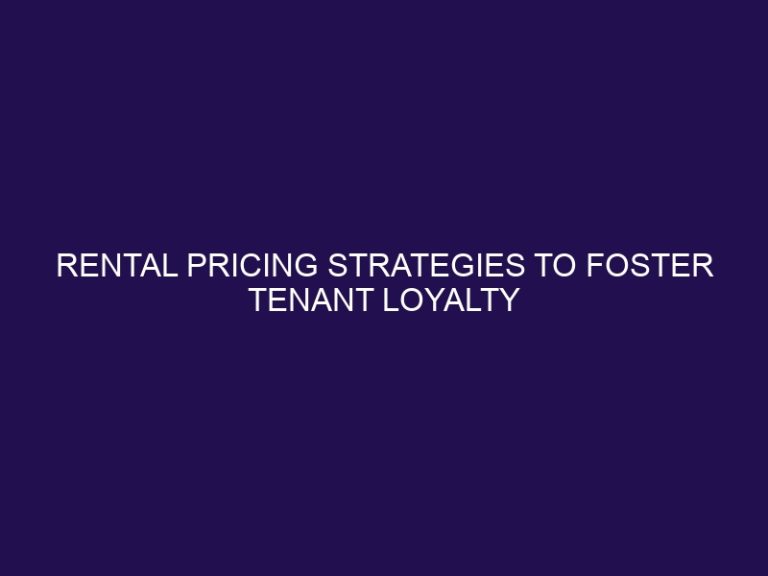Should you allow pets in your rental?
Allowing pets in rental properties is a decision that many landlords grapple with. While it may come with its challenges, there are several benefits to consider. Allowing pets can expand your potential tenant pool, increase rental demand, and promote longer tenant retention. Furthermore, it may even allow you to charge a potential rental premium. However, there are important considerations to keep in mind when allowing pets in rentals. Implementing a clear and comprehensive pet policy and agreement is essential to protect both landlords and tenants. Addressing landlord concerns such as property damage mitigation, tenant accountability, and pet allergies and health concerns is crucial. If allowing pets is not feasible, alternatives such as offering pet-friendly amenities, implementing pet deposits and additional fees, or imposing pet restrictions and limitations can strike a balance between accommodating tenants with pets and maintaining the integrity of the property. By carefully weighing the benefits and considerations, landlords can make an informed decision on whether to allow pets in their rental properties.
Benefits of Allowing Pets in Rentals
Did you know that allowing pets in rentals can bring numerous benefits? In this section, we’ll discover the advantages of welcoming furry friends into your rental property. From an increased tenant pool and higher rental demand to longer tenant retention and the potential for a rental premium, there are compelling reasons to consider this pet-friendly approach. We’ll also touch upon important aspects like property damage protection, liability considerations, and the screening and approval process. So, let’s dive into the world of pet-friendly rentals!
Increased Tenant Pool
Allowing pets in rentals can result in an increased tenant pool, attracting more potential renters who own pets. This can lead to higher rental demand and longer tenant retention, as pet owners often struggle to find pet-friendly housing. To address concerns about property damage and liability, landlords can implement a pet policy and agreement, require pet deposits or additional fees, and screen and approve tenants with pets. Alternatively, landlords can consider offering pet-friendly amenities or implementing specific pet restrictions and limitations. Ultimately, allowing pets in rentals can be a beneficial decision that expands the pool of potential tenants and enhances rental property desirability.
Higher Rental Demand
Allowing pets in rentals can result in a surge of higher rental demand due to the expanded tenant pool. Many renters actively seek pet-friendly properties, which gives landlords a competitive advantage. By accommodating pets, landlords have the opportunity to attract a larger pool of potential tenants, resulting in lower vacancy rates and faster property rentals. This increased demand also allows landlords to charge a potential rental premium, thereby boosting their rental income. It is crucial for landlords to establish a well-defined pet policy and agreement to address concerns such as property damage and liability protection. By effectively addressing these issues, landlords can leverage the heightened rental demand generated by allowing pets.
As an intriguing historical illustration, pets played a significant role in bolstering rental demand during World War II. As people were evacuated from major cities and required temporary accommodation, numerous landlords permitted pets in their rentals to offer comfort and emotional support to their tenants. This led to a surge in demand for pet-friendly rentals, resulting in higher occupancy rates and increased rental income for landlords.
Longer Tenant Retention
Allowing pets in rentals can result in longer tenant retention. When landlords choose to permit tenants to have pets, it not only enhances their overall satisfaction but also increases their willingness to stay in the rental property for an extended period. Tenants who own pets often face difficulties in finding suitable housing options. Therefore, when they come across a pet-friendly rental, they are more likely to stay and renew their lease. Consequently, this helps minimize turnover and vacancy rates for landlords, leading to a more stable and profitable rental business. By accommodating pets, landlords can foster a loyal and content tenant base, ultimately resulting in longer-term tenancy and a positive rental experience for both parties involved.
Potential Rental Premium
Allowing pets in rentals can potentially lead to a rental premium. Here are factors to consider:
- Market Demand: Allowing pets in rentals can result in higher rental prices due to the growing demand for pet-friendly rentals.
- Increased Tenant Pool: By allowing pets, landlords can expand their pool of prospective tenants, increasing the likelihood of finding reliable and responsible renters and potentially leading to a rental premium.
- Longer Tenant Retention: Rental properties that allow pets often benefit from longer tenant retention. Pet owners tend to stay longer, reducing turnover costs and ensuring a stable rental income, which can contribute to a potential rental premium.
- Higher Rental Demand: Pet-friendly rentals are in high demand, allowing landlords to charge a premium for accommodating pets and potentially leading to a rental premium.
A landlord who allowed pets in their rental property was able to charge a rental premium. They attracted responsible pet owners who stayed long-term, leading to a consistent and profitable rental income, with the potential for a rental premium.
Pet Policy and Agreement
Looking to make an informed decision about allowing pets in your rental property? Let’s dive into the Pet Policy and Agreement, where we’ll explore the benefits of implementing such a policy. From attracting a larger tenant pool and meeting the rising demand for pet-friendly rentals to ensuring longer tenant retention and potentially charging a rental premium, we’ll uncover the advantages. We’ll address concerns such as property damage and liability protection, as well as the screening and approval process. Stick around to make an informed choice!
Property Damage and Liability Protection
When considering allowing pets in rentals, it is crucial to take into account the matter of property damage and liability protection. Here are some factors to bear in mind:
- Develop a comprehensive pet policy and agreement that clearly outlines the responsibility of pet owners in relation to property damage.
- Mandate that pet owners present evidence of liability insurance to safeguard against any possible damages caused by their pets.
- Establish a thorough screening and approval process for tenants with pets to ensure that they are responsible pet owners.
- Consider the requirement of a pet deposit or additional fees to cover any potential damages caused by pets.
- Enforce limitations and restrictions on the types and sizes of pets allowed in order to minimize the risk of property damage.
By addressing property damage and liability protection, landlords can mitigate potential risks while still accommodating tenants with pets.
Screening and Approval Process
- To ensure responsible pet ownership and minimize potential risks and issues, the screening and approval process for allowing pets in rentals involves several steps.
- Require pet applications: Ask potential tenants to fill out a separate pet application, including information about the pet’s breed, age, size, and temperament.
- Verify pet references: As part of the screening and approval process, contact previous landlords or veterinarians to gather information about the pet’s behavior, training, and any incidents of damage or complaints.
- Set pet policies: Within the screening and approval process, create clear guidelines regarding pet size, breed restrictions, and behavioral expectations, ensuring they align with any legal requirements or insurance policies.
- Meet the pet: Arrange a meeting between the landlord and the pet as part of the screening and approval process to assess compatibility and ensure the pet is well-behaved and properly cared for.
- Collect additional fees: As part of the screening and approval process, charge pet fees or deposits to cover any potential damage or additional cleaning required due to the pet’s presence.
True story: One landlord implemented a thorough screening and approval process for pets in their rental. After going through the screening and approval process, which included verifying pet references and meeting the pet, the landlord allowed the pet in the rental. The tenant and their furry companion lived harmoniously, and the landlord had peace of mind knowing that their screening and approval process ensured a responsible pet owner.
Addressing Landlord Concerns
Concerned about allowing pets in your rental property? Dive into the section addressing landlord concerns, where we’ll tackle the important aspects surrounding this topic. From minimizing property damage to ensuring tenant accountability, addressing pet allergies and health concerns, exploring pet deposits and extra fees, and understanding pet restrictions and limitations, this section has got you covered. Let’s navigate the ins and outs of allowing pets in rentals and make an informed decision.
Property Damage Mitigation
Property damage mitigation is an essential aspect to consider when allowing pets in rental properties. By implementing specific measures, landlords can effectively minimize the risk of potential damage caused by pets.
- One effective approach is to provide pet-friendly amenities, such as designated pet areas or outdoor spaces.
- Additionally, landlords can require tenants to pay a pet deposit or additional fees to cover any potential damage that may occur.
- It is also advisable to establish clear pet restrictions and limitations, including breed restrictions or size limitations.
By employing these strategies, landlords can effectively protect their property and prevent excessive damage. In fact, according to a study conducted by the American Pet Products Association, rental properties that implement property damage mitigation measures experience a considerable reduction in pet-related damages compared to those that do not.
Tenant Accountability
Tenant accountability is a critical factor to consider when allowing pets in rentals. Here are some essential considerations:
- Clear guidelines and rules in the rental agreement regarding pet responsibilities and behavior.
- Regular inspections to ensure tenants are properly maintaining the property and addressing any pet-related issues.
- Open communication with tenants, addressing any concerns or violations promptly.
- Require tenants to provide evidence of pet’s vaccinations, licenses, and insurance coverage.
- Impose pet-related fees or deposits to hold tenants accountable for damages or extra cleaning required.
Pro-tip: Establishing clear guidelines and open communication can help prevent conflicts and ensure responsible pet ownership in rental properties.
Pet Allergies and Health Concerns
When considering allowing pets in rentals, it is important to address pet allergies and health concerns. Here are some important considerations for pet owners and tenants with allergies:
- Inform tenants about potential allergens: Provide detailed information about the presence of pets in the building to help tenants with pet allergies make an informed decision.
- Ensure proper cleaning: Implement thorough cleaning protocols to minimize allergens and maintain a healthy living environment for all residents.
- Require vaccinations: Make it a requirement for tenants to provide documentation of up-to-date vaccinations for their pets. This helps prevent the spread of diseases and protects the health of all individuals living in the building.
- Establish pet restrictions: Consider implementing restrictions on certain pet breeds or sizes that may pose higher health risks or trigger allergies. This ensures the safety and well-being of both pet owners and non-pet-owning tenants.
- Encourage pet-friendly spaces: Designate specific areas within the building where pets are allowed. This helps minimize contact between allergens and non-pet-owning tenants, creating a harmonious living environment for everyone.
Pet-friendly Amenities
When it comes to making your rental property more appealing to potential tenants, pet-friendly amenities can make all the difference. Let’s dive into the advantages that come with embracing furry friends in your rental. From expanding your tenant pool to increasing rental demand and even securing longer tenant retention, there are numerous benefits to creating a pet-friendly environment. We’ll also explore the potential for rental premium, address concerns about property damage and liability, and discuss the importance of a thorough screening and approval process for pet owners.
Pet Deposits and Additional Fees
When considering whether to allow pets in rentals, landlords often impose pet deposits and additional fees to mitigate potential risks and cover any damages caused by pets. Here are some key points to consider:
- Pet Deposits: Landlords may require a separate deposit specifically for pets to cover any potential damages.
- Additional Fees: Some landlords charge additional fees on top of the monthly rent to accommodate the presence of pets.
- Offsetting Risks: These deposits and fees help offset the risks associated with allowing pets in rentals, such as property damage or increased wear and tear.
- Legal Considerations: Landlords should consult local laws and regulations regarding the maximum amount they can charge for pet deposits and additional fees.
Pet Restrictions and Limitations
- Incorporating pet restrictions and limitations in rentals is essential to ensure a harmonious living environment for all tenants.
- Here are some important considerations to include in your pet policy:
- Implementing breed and size restrictions to accommodate the property space.
- Enforcing limits on the number of pets to prevent overcrowding.
- Requiring tenants to provide proof of vaccinations and spaying/neutering to promote responsible pet ownership.
- Establishing pet-friendly areas and amenities to create designated spaces for pets.
- Implementing noise regulations to address barking and other disturbances.
Frequently Asked Questions
Should I allow pets in my rental property?
Allowing pets in your rental property is a decision that has both pros and cons to consider. Some of the pros include the potential for higher rent, longer tenant tenure, a larger pool of applicants, and responsible pet owners being more likely to be responsible tenants. However, there are also cons to allowing pets, such as the risk of pet damage, noise disturbance, offensive odors, and the potential for injuries to other tenants. It is important to weigh these factors and consider implementing guidelines for pet ownership in your rental property.
How can allowing pets affect the market value of my rental property?
Allowing pets in your rental property can potentially increase its market value. By accepting tenants with pets, you open your property to a larger pool of applicants who are willing to pay more for pet-friendly accommodations. Additionally, responsible pet owners are more likely to be responsible tenants, resulting in longer tenure and fewer turnovers, which can positively impact the market value of your rental property.
What steps can I take to prevent pet damage in my rental property?
To prevent pet damage in your rental property, it is essential to screen tenants with pets carefully. Ask for references and past rental history to ensure they have been responsible pet owners in the past. You can also request an additional pet deposit or pet rent to cover any potential damage. Implementing pet guidelines, such as restrictions on the size or breed of pets, can also help minimize the risk of pet damage.
How can I address noise disturbance caused by pets in a rental property?
Noise disturbance caused by pets can be addressed by implementing specific rules and guidelines for pet owners in your rental property. These rules can include quiet hours, limitations on the number of pets allowed, and requirements for tenants to address excessive noise or barking issues promptly. Clear communication with tenants about noise expectations is essential to ensure a peaceful living environment for all residents.
What legal considerations should I be aware of when allowing pets in my rental property?
When allowing pets in your rental property, it is important to be aware of the applicable laws and regulations in your area. Familiarize yourself with any local ordinances or restrictions regarding pet ownership, breed restrictions, and pet-related liability. It is also recommended to consult with legal professionals specialized in real estate to ensure you are in compliance with all legal requirements.
How can I screen a tenant with pets for my rental property?
To effectively screen a tenant with pets for your rental property, you can request information and references specific to their pet ownership. This may include asking for veterinary references to confirm their pet is up to date on vaccinations and well cared for. You can also inquire about their previous rental experiences with pets and ask for references from previous landlords to assess their responsibility as a pet owner and tenant.







